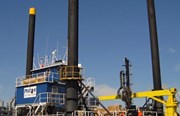Using Sonic for SPT Sampling
By: Bill PoupisWhen choosing drilling technologies for different projects, many of us rely on tried-and-true methods. But are we missing out on more efficient options? In a recent webinar, I discussed using sonic technology for tieback anchor installation, which saved our client weeks of installation time and associated costs. If you missed the live webinar, you can watch the recording now.
In this blog post, I’ll highlight another geotechnical application where you should consider using sonic technology: standard penetration test (SPT) sampling.
Benefits of Sonic Technology
Sonic technology offers several key benefits:
-
Fast Drill Time: Sonic drilling significantly reduces the time required for drilling.
-
Minimizes Drill Waste: It generates less waste compared to traditional methods.
-
Fewer Refusals: There are fewer refusals due to subsurface conditions.
-
Smaller Footprint: Sonic rigs often have a smaller footprint than other drilling technologies.
Despite these advantages, sonic is not the standard method for SPT sampling. Many geotechnical consultants have questions and concerns about its use in this application. Let’s address three of the most common concerns:
-
Does Sonic Drilling Affect Soil Conditions Beyond the Drill Head?
-
Is the SPT Data Collected Accurate?
- Have There Been Any Side-by-Side Comparisons Using Conventional and Sonic Drilling Methods?
1. Does Sonic Drilling Affect Soil Conditions Beyond the Drill Head?
Yes, but not significantly. Engineers and manufacturers of sonic heads explain that the energy created by the sonic head is transmitted through the sonic casing, keeping the formation in a "fluid" state, often referred to as "liquefaction." This occurs when vibrations or water pressure within the soil cause the particles to lose contact with one another. However, the impact to the borehole is minimal—only about 1/8 of an inch.
2. Is the SPT Data Collected Accurate?
Yes. According to experts, SPT data collected using sonic drilling methods is accurate and reliable. The energy and vibrations from the sonic head do not significantly alter the integrity of the soil conditions being tested.
3. Have There Been Any Side-by-Side Comparisons Using Conventional and Sonic Drilling Methods?
Yes. For example, Aquifer Drilling and Testing, A Cascade Company, completed a project using both mud rotary core drilling and sonic drilling to collect SPT samples. Although the rigs were on different parts of the site, the SPT data collected was extremely close—close enough to accept the sonic data for designing the structure being built.
Why Consider Sonic for SPT Sampling?
Sonic's accuracy in SPT sampling, combined with its other benefits, makes it an increasingly attractive option for site characterization projects, especially those with tight deadlines. Sonic is not only faster but can also be used for both environmental and geotechnical investigations. Using the same borehole to collect both sets of data results in significant time savings, cost reductions, and waste minimization.
Conclusion
If you haven’t considered Sonic for your SPT sampling projects, it’s worth taking another look. The efficiency and reliability of sonic technology can offer substantial benefits for your next project.
For more information and to see how sonic drilling can benefit your project, watch our webinar recording.













